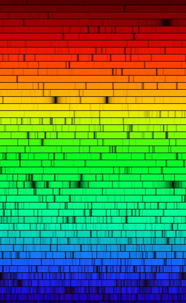Educational Activities


NOAO

National Geographic

Navigant Research

NASA

ESO






Astronomy is a discipline pursued at a distance. And yet measuring the physical distances to astrophysical objects takes both ingenuity and
phenomenal advancements in technology. The following activities will help students understand distances in astronomy, from powers
of 10 to measuring the incredible breadth to distant planets, stars and galaxies.
— Powers of Ten (PDF, Plus additional PDF of images and answers)
— Parallax (PDF)
— Biology: size of microorganisms and atmospheric particles
— Chemistry: size of atoms, nanotechnology, bonding, and atomic scale
— Earth/Geology/Environmental Science: size and geochemical cycles
— Engineering: engineering notation
— Mathematics: algebraic computations and geometric applications
— Physics: metric system and scientific notation
The most powerful tool in astronomy is light — photons traveling billions of lightyears across the cosmos before getting
scooped up by an array of radio dishes or a single parabolic mirror orbiting the Earth. By collecting these photons in different
filters, or spreading them across a spectrum of wavelengths, we have placed ourselves within the vistas of seemingly endless time
and space.
— Light & Color (PDF)
— Spectra & Chemical Composition (PDF)
— Biology: color perception, vision, wavelengths of light traveling through different media (e.g., how different algea types grow in difference light) and bioluminescence
— Chemistry: chemiluminescence, phosphorescence and flourescence
— Earth/Geology/Environmental Science: mineral identification and soil compositions
— Engineering: materials science
— Mathematics: inverse relationships
— Physics: wave properties, frequency, speed wavelength, transmission of light through various media and filters
Nothing is more powerful than a vast starry sky displayed above you. Except perhaps, an advanced planetarium that allows the user
to speed up and slow down time, change location, and even zoom in on distant phenomena.
— Observing the Night Sky (PDF)
— Biology: night vision and photoreceptors (cones, rods)
— Chemistry: effects of pollutants on seeing
— Earth/Geology/Environmental Science: amount of daylight, seasons and archaeostronomy connections
— Engineering: satellite trajectories
— Mathematics: degrees, arc minutes and arc seconds
— Physics: concave/convex lenses and focal points
Heat is energy. Most of our primary methods of creating electrical power come down to generating heat & coal, natural gas, even
nuclear. The heat energy stored in the cores of planets drives their geologic activity, and determines whether a planet is
geologically dead (like Mars), or active (like Earth). With special materials called thermoelectrics, we can examine the use of heat
as an energy source.
— Heat Energy (PDF)
— Biology: extremophiles and thermal ocean vents
— Chemistry: endothermic/exothermic reactions and burning splint tests
— Earth/Geology/Environmental Science: energy types and sources
— Engineering: spaceship designs that withstand extreme temperatures
— Mathematics: Newton's law of cooling, heat transfer and temperature changes
— Physics: conductors and insulators
Based on distant orbiting satellites we can date worlds, understand various surface features and even model
their interior structures. Planetary geology is a powerful tool that helps us
understand why nearby planets, such as Venus and Mars, are vastly different from
our home.
— Detecting Distant Exoplanets (PDF)
— Planetary Geology (PDF)
— Biology: environmental regions, habitable zones and detecting life on other planets
— Chemistry: chemical composition of soils
— Earth/Geology/Environmental Science: chemical composition of atmospheres, moon spirals, magnetic forces and earthquake waves used to model Earth's interior
— Engineering: space probes designed to fly by or land on other planets
— Mathematics: Kepler's laws of planetary motion and coding/decoding images
— Physics: planet properties (mass, volume, density, gravitational field, atmosphere, magnetic field)
Zooniverse — the renowned home of citizen science projects — allows private citizens across the world to make meaningful
contributions to science. Many projects have produced unique scientific results, ranging from individual discoveries to
classifications that rely on input from thousands of viewers. Here are a few activities to help students become engaged in science
in a meaningful way.
— Galaxy Zoo (PDF)
— Biology: ocean life, cancer cell research, genetic, plankton, california condors and notes from nature
— Chemistry: star formation and explosions in the Sun
— Earth/Geology/Environmental Science: climate data from ship logs, tropical cyclone data, the Moon's surface, and Mars
— Engineering: echolocation
— Mathematics: modeling and decoding
— Physics: galaxy formation, sunspots, planet formation, exoplanets and black hole jets